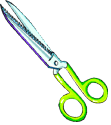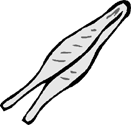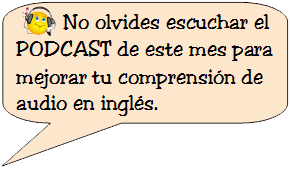English Exercises > irregular verbs exercises > Past Simple/ "You needed me" song by Anne Murrah
IRREGULA VERBS
READ THE FOLLOWING TITLE AND SOLVE THE EXERCISES (LEA EL SIGUIENTE TITULO Y RESUELVA LOS EJERCICIOS) RECUERDE QUE ESTAS ACTIVIDADES SON DEL CUARTO PERIODO)
PAST SIMPLE: REGULAR VERBS- EXERCISES

Practice the Past Tense
- Exercise
- Exercise
- Exercise
- Exercise
- Exercise
- Write negative sentences
- Write negative sentences
- Write affirmative sentences
- Write affirmative sentences
- Write interrogative sentences
- Write interrogative sentences
- Wh-Questions
- Wh-Questions
- Wh-Questions: Order the words to make questions
- Who Subject questions: Order the words to make questions
- Who Subjects questions
- Pronunciation: /t/ /d/ /id/
- Hangman game for verbs
CUARTO PERIODO ( FOURTH TERM)
| |||
Countable nouns – Count nouns
A noun renames a person, place or thing. If a noun is viewed as countable if:
• A or an can be used in front of it : a table, an egg
• It has a plural form : there are two tables
• It can be used in a question with how many: How many rooms are there?
• A number can be used before it: four computers
• It has a plural form : there are two tables
• It can be used in a question with how many: How many rooms are there?
• A number can be used before it: four computers
If a noun is viewed as uncountable:
• a/an cannot be used in front of it: Cereal is healthy
• it does not have a plural form: I like butter (NOT BUTTERS)
• it can be in a question with how much: How much sugar would you like?
• a number isn’t used in front of it: It has little caffeine.
• it always takes a “singular” verb: Milk is good for you.
• it does not have a plural form: I like butter (NOT BUTTERS)
• it can be in a question with how much: How much sugar would you like?
• a number isn’t used in front of it: It has little caffeine.
• it always takes a “singular” verb: Milk is good for you.
*** En si los sustantivos contables son aquellos que puedes contar (poner un numero antes del sustantivo: una mesa pero no una agua Todos los liquidos como agua, leche, cerveza, vino son no contables (EN ESPAÑOL PUEDE SER DISTINTO). Tambien las carnes son no contables como pollo, pescado etc.
TABLE
USING THERE IS / ARE WITH COUNTABLE and UNCOUNTABLE NOUNS
| ||
Countable
|
Uncountable
| |
Singular
|
Plural
|
One form
|
| (+)There is a chair. | There are some chairs. | There is some water |
| (-) There isn’t a table. | There aren’t any tables. | There isn’t any cheese. |
| (?) Is there a bathroom? | Are there any bathrooms? | Is there any coffee? |
Conclusions from the table:
• With countable nouns we have two forms: singular and plural and when we refer to uncountable nouns we only use one form.
• When we use the singular form with countable nouns we use a/an and with plurals we use some/any.
• With the uncountable nouns we do not use a/an and we can use some/any
• With countable nouns some/any means “an indefinite number”
• With uncountable nouns some/any means “a portion of”
• With countable nouns we have two forms: singular and plural and when we refer to uncountable nouns we only use one form.
• When we use the singular form with countable nouns we use a/an and with plurals we use some/any.
• With the uncountable nouns we do not use a/an and we can use some/any
• With countable nouns some/any means “an indefinite number”
• With uncountable nouns some/any means “a portion of”
Conclusiones:
Como vemos cuando un sustantivo es contable hay dos formas: singular y plural pero con los no constables solo hay una forma. Nunca usen la forma plural cuando usen los no contables. También cabe resaltar que cuando usamos el some /any con los contables significa algunos/algunas o en negativo ningun pero cuando se usa con los no contables quiere decir algo de. Veamos:
There are some books on the table. (Hay algunos libros)
There aren’t any books. (No hay ningun lbro) Ojo que en español se usa la forma singular de libro pero en inglés no.
Are there any books? (Hay algún libro)There is milk. (Hay algo de leche)
There isn’t any milk. (No hay nada de leche)
Is there any milk? (Hay algo de leche?)
There aren’t any books. (No hay ningun lbro) Ojo que en español se usa la forma singular de libro pero en inglés no.
Are there any books? (Hay algún libro)There is milk. (Hay algo de leche)
There isn’t any milk. (No hay nada de leche)
Is there any milk? (Hay algo de leche?)
ACTIVITY
POR FAVOR DAR CLICK EN LOS SIGUIENTES LINKS Y DESARROLLAR LOS EJERCICIOS. NO OLVIDE COPIARLOS EN SU CUADERNO.
ONLINE EXERCISES – EJERCICIOS EN LINEA:
Identify if the noun is countable or uncountable (Identificar si el sustantivo es contable o no)
-http://www.usingenglish.com/quizzes/210.html
-http://www.usingenglish.com/quizzes/210.html
-http://www.usingenglish.com/quizzes/210.html
-http://www.usingenglish.com/quizzes/210.html


Al igual que en español, cuando queremos hacer comparaciones contrastamos cualidades o atributos por medio de adjetivos en sus diversos grados.
VIDEO FROM YOUTUBE
Grades of Adjectives (Grados de adjetivos)
- El grado positivo es la cualidad en el grado más simple.
- Ejemplos:
- Juan runs fast. (Juan corre rápido.)
- Angela's room is clean. (La habitación de Angela está limpia.)
- I am tall. (Soy alto.)
- New York is big. (Nueva York es grande.)
- El grado comparativo puede ser de superioridad, inferioridad o igualidad. Para comparativos de superioridad o inferioridad, el adjetivo es seguido por "than". Para comparativos de inferioridad, usamos "not as...as" o "less" delante del adjetivo. Y para comparativos de igualidad, el adjetivo va entre "as...as".
- Ejemplos:
- Comparativos de superioridadPlay
- Juan runs faster than Mark. (Juan corre más rápido que Mark.)
- Angela's room is cleaner than Sue's. (La habitación de Angela está más limpia que la de Sue.)
- I am taller than Beth. (Soy más alto que Beth.)
- New York is bigger than Los Angeles. (Nueva York es más grandeque Los Angeles.)
- Comparativos de inferioridad
- Mark doesn't run as fast (slower) as Juan. (Mark no corre tan rápido como Juan.)
- Sue's room is not as clean (dirtier) as Angela's. (La habitación de Sue no es tan limpia como la de Angela.)
- Beth is not as tall (shorter) as me. (Beth no es tan alta como yo.)
- Los Angeles is not as big (smaller) as New York. (Los Angeles no es tan grande como Nueva York.)
- Comparativos de igualidad
- Mark is as fast as Juan. (Mark corre tan rápido como Juan.)
- Sue's room is as clean as Angela's. (La habitación de Sue es tan limpia como la de Angela.)
- Beth is as tall as I am. (Beth es tan alta como yo.)
-
Los Angeles is as big as New York. (Los Angeles es tan grande como Nueva York.)
Nota: Podemos modificar un comparativo con un cuantificador (much, a lot, a little, slightly...).
- Ejemplos:
- Juan runs a lot faster than Mark. (Juan corre mucho más rápido que Mark.)
- I am slightly taller than Beth. (Soy un poco más alta que Beth.)
- El grado superlativo denota la calidad en el grado más alto y como espanol, se usa "the" delante del adjetivo.
- Ejemplos:
- Juan is the fastest. (Juan es el más rápido.)
- Angela'a room is the cleanest. (La habitación de Angela es la más limpia.)
- I am the tallest. (Soy el más alto.)
- New York is the biggest city in the United States. (Nueva York el la cuidad más grande de los Estados Unidos.)
- Ejemplos:
- His smartest student is Lisa. (Su estudiante más lista es Lisa.)
- New York is coldest in January. (Nueva York es más frio en enero.)
fast, hard, smart, pretty, clean, large, small, old, easy...
Nota: Si el adjetivo es posesivo, no se usa "the". Además no se usa "the" si comparamos algo con si mismo.
Form (Forma)
Hay unas reglas para formar el comparativo y superlativo.
- Para adjetivos de una sílaba:
- Para adjetivos de una sílaba que terminan en "e":
- Para adjetivos de una sílaba que terminan en constanante + vocal + constanante:
- Para adjetivos de dos silabas que terminan en "y":
- Para adjetivos de dos o más silabas:
- Adjetivos irregulares:
| Comparativo | Superlativo |
| añade: "-er" ( faster) | añade: "-est" ( fastest) |
| Comparativo | Superlativo |
| añade: "-r" ( nicer) | añade: "-st" ( nicest) |
| Comparativo | Superlativo |
| añade: constanante + "er" ( hotter) | añade: constanante + "-est" ( hottest) |
| Comparativo | Superlativo |
| sustituye "y" por: "-ier" ( funnier) | sustituye "y" por: "-iest" ( funniest) |
| Comparativo | Superlativo |
| añade: "more"/"less" ( morebeautiful) | añade "the most"/"the least": ( the mostbeautiful) |

| Adjetivo | Comparativo | Superlativo |
| good | better | best |
| bad | worse | worst |
| far | further | furthest |
CURSO DE INGLES SEGUNDO PERIODO:
PRUEBA DE NIVEL AQUI:http://www.mansioningles.com/pruebanivel/pruebanivel1.htmINICIE SU CURSO DE ACUERDO CON SU NIVEL.
Ohttp://es-mx.livemocha.com/
CONSULTA ESTA PAGINA PARA QUE INICIES UN CURSO VIRTUAL
http://www.mansioningles.com/cursoinicia/cursoinicia01_1.htm
PARA CONTINUAR EL CURSO DA CLICK AQUÍ Y ESCOGE CURSO DE INICIACIÓN:
http://www.mansioningles.com/NuevoCurso.htm
PARA CONTINUAR EL CURSO DA CLICK AQUÍ Y ESCOGE CURSO DE INICIACIÓN:
http://www.mansioningles.com/NuevoCurso.htm
 1. |  2. |  3. | ||
 4. |  5. |  6. |
JÓVENES PARA REALIZAR SU CURSO VIRTUAL POR FAVOR CONSULTE ESTA PAGINA:
FEBRUARY 29TH/12
ACTIVITY:
QUERIDOS ESTUDIANTES, RESUELVAN ESTOS EJERCICIOS EN SU CUADERNO.
ES NECESARIO EN PRIMER LUGAR BUSCAR EL SIGNIFICADO DE LOS VERBOS DEL RECUADRO PARA QUE PUEDAN COMPLETAR EL EJERCICIO.
REMEMBER:
Presente Simple - (Simple Present Tense)
El Presente Simple es un tiempo verbal que se utiliza para describir acciones habituales que suceden con cierta frecuencia y no hace referencia a si está ocurriendo en el momento actual.
A continuación se muestran las formas afirmativa, interrogativa y negativa de este tiempo verbal:
 En el cuadro superior se ha tomado como ejemplo el verbo PLAY (jugar). Observe que en el modo afirmativo, en la 3º persona del singular, se le añade una "S" al verbo.
En el cuadro superior se ha tomado como ejemplo el verbo PLAY (jugar). Observe que en el modo afirmativo, en la 3º persona del singular, se le añade una "S" al verbo.
En el modo interrogativo y negativo se utiliza el auxiliar DO, aunque en la 3º persona del singular se coloca como auxiliar DOES y se le quita la "S" al verbo.
Existen algunos casos particulares como por ejemplo, si el verbo empleado termina en "SS", "SH", "CH", "O" y "X" al formar la 3º persona del singular en la forma afirmativa se le agrega "ES". Aquí vemos algunos ejemplos:
Si el verbo es FISH (pescar), se conjugará: He fishes at the sea. Él pesca en el mar.
Si el verbo es KISS (besar), se conjugará: She kisses to her boyfriend. Ella besa a su novio.
Si el verbo es WATCH (observar), se conjugará: He watches the mountain. Él observa la montaña.
Si el verbo es FIX (arreglar), se conjugará: He fixes his car. Él arregla su coche.
Si el verbo es GO (ir), se conjugará: She goes to the office. Ella va a la oficina.
Otra excepción se presenta si el verbo termina en "Y" tras consonante. Para formar la 3º persona del singular se sustituye esta "Y" por una "i" acompañada de la terminación "ES". Por ejemplo:
Si el verbo es STUDY (estudiar) se conjugará: She studies the lesson. Ella estudia la lección.
Para la forma negativa se puede emplear la forma contraída de DON'T en lugar de DO NOT o DOESN'T en vez de DOES NOT.
I play tennis. Yo juego al tenis.
(Hace mención de un deporte que realizo cotidianamente y que no necesariamente lo estoy jugando en este momento).
He works in an office. Él trabaja en una oficina.
(Se refiere al trabajo que desarrolla una persona frecuentemente).
They travel to Madrid. Ellos viajan a Madrid.
(Habla de un viaje que se repite a diario, aunque el sujeto no lo esté realizando ahora).
(Hace mención de un deporte que realizo cotidianamente y que no necesariamente lo estoy jugando en este momento).
He works in an office. Él trabaja en una oficina.
(Se refiere al trabajo que desarrolla una persona frecuentemente).
They travel to Madrid. Ellos viajan a Madrid.
(Habla de un viaje que se repite a diario, aunque el sujeto no lo esté realizando ahora).
A continuación se muestran las formas afirmativa, interrogativa y negativa de este tiempo verbal:
 En el cuadro superior se ha tomado como ejemplo el verbo PLAY (jugar). Observe que en el modo afirmativo, en la 3º persona del singular, se le añade una "S" al verbo.
En el cuadro superior se ha tomado como ejemplo el verbo PLAY (jugar). Observe que en el modo afirmativo, en la 3º persona del singular, se le añade una "S" al verbo.
He eats vegetables. Él come vegetales.
Alice dances at the theatre. Alice baila en el teatro.
The dog breaks the fence. El perro rompe la cerca.
Alice dances at the theatre. Alice baila en el teatro.
The dog breaks the fence. El perro rompe la cerca.
En el modo interrogativo y negativo se utiliza el auxiliar DO, aunque en la 3º persona del singular se coloca como auxiliar DOES y se le quita la "S" al verbo.
Existen algunos casos particulares como por ejemplo, si el verbo empleado termina en "SS", "SH", "CH", "O" y "X" al formar la 3º persona del singular en la forma afirmativa se le agrega "ES". Aquí vemos algunos ejemplos:
Si el verbo es FISH (pescar), se conjugará: He fishes at the sea. Él pesca en el mar.
Si el verbo es KISS (besar), se conjugará: She kisses to her boyfriend. Ella besa a su novio.
Si el verbo es WATCH (observar), se conjugará: He watches the mountain. Él observa la montaña.
Si el verbo es FIX (arreglar), se conjugará: He fixes his car. Él arregla su coche.
Si el verbo es GO (ir), se conjugará: She goes to the office. Ella va a la oficina.
Otra excepción se presenta si el verbo termina en "Y" tras consonante. Para formar la 3º persona del singular se sustituye esta "Y" por una "i" acompañada de la terminación "ES". Por ejemplo:
Si el verbo es STUDY (estudiar) se conjugará: She studies the lesson. Ella estudia la lección.
Para la forma negativa se puede emplear la forma contraída de DON'T en lugar de DO NOT o DOESN'T en vez de DOES NOT.
I don't play tennis. Yo no juego al tenis.
He doesn't work in an office. Él no trabaja en una oficina.
They don't travel to Madrid. Ellos no viajan a Madrid.
He doesn't work in an office. Él no trabaja en una oficina.
They don't travel to Madrid. Ellos no viajan a Madrid.
ACTIVITY:
QUERIDOS ESTUDIANTES, RESUELVAN ESTOS EJERCICIOS EN SU CUADERNO.
ES NECESARIO EN PRIMER LUGAR BUSCAR EL SIGNIFICADO DE LOS VERBOS DEL RECUADRO PARA QUE PUEDAN COMPLETAR EL EJERCICIO.
|
GAMES
APRENDA LOS VERBOS CON ESTE
JUEGO:
JUEGO:
Asocia cada situación del mundo de la empresa con su correspondiente término. (si no visualizas correctamente los ejercicios accede al cuaderno online)

1.

2.

3.

4.

5.

6.
RECORDERIS SOBRE ADJETIVOS POSESIVOS ( POSSESSIVE ADJECTIVES)
 · APRENDE UN POCO MÁS.
ADJETIVOS POSESIVOS
Los adjetivos posesivos en inglés hacen referencia al poseedor y no a la cosa poseída y se usan con más frecuencia en inglés que en español.
· APRENDE UN POCO MÁS.
ADJETIVOS POSESIVOS
Los adjetivos posesivos en inglés hacen referencia al poseedor y no a la cosa poseída y se usan con más frecuencia en inglés que en español.
Preceden normalmente a los sustantivos que indican partes del cuerpo, parentesco, vestimenta y objetos personales, nombres que se usan en español con el artículo determinado:
John is washing his hands / John se lava las manos (sus manos)my, mi(s), mío
- Se utiliza my para indicar que algo pertenece o se relaciona con uno mismo.
That's my watch / Ese es mi relojyour, tu(s), su(s)
- Se utiliza your para indicar que algo pertenece a la persona a la que se está hablando. Equivale al 'tu, su / vuestro, vuestros' español. Fijate que el tratamiento en inglés no cambia, a diferencia de la distinción en español del tú y el su (de usted).
I like your shoes / Me gustan tus zapatos his, su (de él)
his, su (de él)
- Se utiliza his para referirnos o indicar la pertenencia de algo a una persona de sexo masculino.
This is his tie / Ésta es su corbataher, su (de ella)
- Se utiliza her para referirnos o indicar la pertenencia de algo a una persona de sexo femenino.
She's broken her arm. / Se ha roto el brazoits, su(s) (de una cosa)
- Se utiliza its para referirnos o indicar la pertenencia de algo a una cosa, lugar o animal. También puede usarse cuando nos referimos a un bebé.
The bird is in its cage / El pájaro está en su jaulaour, nuestro
- Usamos our para referirnos o indicar la pertenencia de algo a un grupo de más de una persona entre las que nos incluimos.
Our house is in the centre of the town / Nuestra casa está en el centro de la ciudadtheir, su(s) (de ellos)
- Usamos their para referirnos o indicar la pertenencia de algo a un grupo de más de una persona entre las que no nos incluimos
What colour is their parrot? / ¿De qué color es su loro?
MARZO 23 DE 2012
SECOND TERM
( SEGUNDO PERIODO)
POR QUE ES IMPORTANTE APRENDER IDIOMAS?
MIREN ESTE VIDEO, QUE NO LES PASE LO MISMO:

Position of adverbs of frequency - Exercise 1
Rewrite the complete sentence using the adverb in brackets in its correct position.
Example: I play tennis on Sundays. (often)
Answer: I often play tennis on Sundays.
1) He listens to the radio. (often)
________________________________________
2) They read a book. (sometimes)
________________________________________
3) Pete gets angry. (never)
________________________________________
4) Tom is very friendly. (usually)
_________________________________________
5) I take sugar in my coffee. (sometimes)
________________________________________
6) Ramon and Frank are hungry. (often)
________________________________________
7) My grandmother goes for a walk in the evening. (always)
_________________________________________
8) Walter helps his father in the kitchen. (usually)
_________________________________________
9) They watch TV in the afternoon. (never)
_________________________________________
10) Christine smokes. (never)
_________________________________________
ACTIVITY
MIREN ESTE VIDEO PARARE FORZAR EL TEMA VISTO EN CLASE ( PRESENT PROGRESSIVE TENSE) COPIEN LAS ACTIVIDADES CON SUS RESPECTIVOS DIBUJOS. TENGAN EN CUENTA LA PRONUNCIACIÓN.
Asocia cada situación relacionada con el mundo de la empresa con su correspondiente término. (si no visualizas correctamente los ejercicios accede al cuaderno online)

1.

2.

3.

4.

5.

6.
 Elige la respuesta correcta.
Elige la respuesta correcta.
1. She speak English very well.
2. - Do you like shopping?
-
3. Why come shopping with us tomorrow?
4. France, Italy and Germany are European .
5. - Is that Juan and Cristina's car?
- No, is the Ford Fiesta.6. - What ?
- He’s having a shower.
7. Pepito usually to work
8. I think leave her husband! 
 Cambia las frases a su forma negativa siguiendo el ejemplo.
Cambia las frases a su forma negativa siguiendo el ejemplo.
Ej. Emma is a teacher.
1. I like Japanese food.
2. She's married.
3. I like vegetables.
4. Pepito likes video games.
5. They live near the beach.
6. Today is Tuesday.
7. I like horror films.
8. David swims very well.
9. Maria is a doctor. 
I like Japanese food
MAY 24TH
Look this video to practice THE USE OF CAN...
THEN COPY IT IN YOUR COPYBOOKS.
LEARN THIS SONG WITH CAN
Asocia cada situación del mundo de la empresa con su correspondiente término. (si no visualizas correctamente los ejercicios accede al cuaderno online)
 1. |  2. |  3. | ||
 4. |  5. |  6. |
RECORDERIS SOBRE ADJETIVOS POSESIVOS ( POSSESSIVE ADJECTIVES)
ADJETIVOS POSESIVOS
Los adjetivos posesivos en inglés hacen referencia al poseedor y no a la cosa poseída y se usan con más frecuencia en inglés que en español.
Preceden normalmente a los sustantivos que indican partes del cuerpo, parentesco, vestimenta y objetos personales, nombres que se usan en español con el artículo determinado:
John is washing his hands / John se lava las manos (sus manos)my, mi(s), mío
- Se utiliza my para indicar que algo pertenece o se relaciona con uno mismo.
That's my watch / Ese es mi relojyour, tu(s), su(s)
- Se utiliza your para indicar que algo pertenece a la persona a la que se está hablando. Equivale al 'tu, su / vuestro, vuestros' español. Fijate que el tratamiento en inglés no cambia, a diferencia de la distinción en español del tú y el su (de usted).
I like your shoes / Me gustan tus zapatos his, su (de él)
his, su (de él)
- Se utiliza his para referirnos o indicar la pertenencia de algo a una persona de sexo masculino.
This is his tie / Ésta es su corbataher, su (de ella)
- Se utiliza her para referirnos o indicar la pertenencia de algo a una persona de sexo femenino.
She's broken her arm. / Se ha roto el brazoits, su(s) (de una cosa)
- Se utiliza its para referirnos o indicar la pertenencia de algo a una cosa, lugar o animal. También puede usarse cuando nos referimos a un bebé.
The bird is in its cage / El pájaro está en su jaulaour, nuestro
- Usamos our para referirnos o indicar la pertenencia de algo a un grupo de más de una persona entre las que nos incluimos.
Our house is in the centre of the town / Nuestra casa está en el centro de la ciudadtheir, su(s) (de ellos)
- Usamos their para referirnos o indicar la pertenencia de algo a un grupo de más de una persona entre las que no nos incluimos
What colour is their parrot? / ¿De qué color es su loro?
Preceden normalmente a los sustantivos que indican partes del cuerpo, parentesco, vestimenta y objetos personales, nombres que se usan en español con el artículo determinado:
John is washing his hands / John se lava las manos (sus manos)my, mi(s), mío
- Se utiliza my para indicar que algo pertenece o se relaciona con uno mismo.
That's my watch / Ese es mi relojyour, tu(s), su(s)
- Se utiliza your para indicar que algo pertenece a la persona a la que se está hablando. Equivale al 'tu, su / vuestro, vuestros' español. Fijate que el tratamiento en inglés no cambia, a diferencia de la distinción en español del tú y el su (de usted).
I like your shoes / Me gustan tus zapatos
 his, su (de él)
his, su (de él)- Se utiliza his para referirnos o indicar la pertenencia de algo a una persona de sexo masculino.
This is his tie / Ésta es su corbataher, su (de ella)
- Se utiliza her para referirnos o indicar la pertenencia de algo a una persona de sexo femenino.
She's broken her arm. / Se ha roto el brazoits, su(s) (de una cosa)
- Se utiliza its para referirnos o indicar la pertenencia de algo a una cosa, lugar o animal. También puede usarse cuando nos referimos a un bebé.
The bird is in its cage / El pájaro está en su jaulaour, nuestro
- Usamos our para referirnos o indicar la pertenencia de algo a un grupo de más de una persona entre las que nos incluimos.
Our house is in the centre of the town / Nuestra casa está en el centro de la ciudadtheir, su(s) (de ellos)
- Usamos their para referirnos o indicar la pertenencia de algo a un grupo de más de una persona entre las que no nos incluimos
What colour is their parrot? / ¿De qué color es su loro?
MARZO 23 DE 2012
SECOND TERM
( SEGUNDO PERIODO)
POR QUE ES IMPORTANTE APRENDER IDIOMAS?
MIREN ESTE VIDEO, QUE NO LES PASE LO MISMO:

Position of adverbs of frequency - Exercise 1
|
ACTIVITY
MIREN ESTE VIDEO PARARE FORZAR EL TEMA VISTO EN CLASE ( PRESENT PROGRESSIVE TENSE) COPIEN LAS ACTIVIDADES CON SUS RESPECTIVOS DIBUJOS. TENGAN EN CUENTA LA PRONUNCIACIÓN.
Asocia cada situación relacionada con el mundo de la empresa con su correspondiente término. (si no visualizas correctamente los ejercicios accede al cuaderno online)
 1. |  2. |  3. | ||
 4. |  5. |  6. |
| 1. She speak English very well. 2. - Do you like shopping? - 3. Why come shopping with us tomorrow? 4. France, Italy and Germany are European . 5. - Is that Juan and Cristina's car? - No, is the Ford Fiesta.6. - What ? - He’s having a shower. 7. Pepito usually to work 8. I think leave her husband! |  |
| Ej. Emma is a teacher. 1. I like Japanese food. 2. She's married. 3. I like vegetables. 4. Pepito likes video games. 5. They live near the beach. 6. Today is Tuesday. 7. I like horror films. 8. David swims very well. 9. Maria is a doctor. | 
I like Japanese food
|
MAY 24TH
Look this video to practice THE USE OF CAN...
THEN COPY IT IN YOUR COPYBOOKS.
THEN COPY IT IN YOUR COPYBOOKS.
LEARN THIS SONG WITH CAN




profe cual de los cursos virtuales se debe hacer.
ReplyDeletelook up the top of this page.
ReplyDeleteprofe me siento confundido cual es el curso que hay que hacer el de live mocha o el de la mansion
ReplyDeleteatt: cristian romero 7-3
profesora hay que copiar todo lo que dice en el video???
ReplyDeleteclaro que si, con las imágenes.
ReplyDeletehaa gracias
ReplyDeleteProfesora Ahi Que Hacer Todo este Curso COn videos & todo ??
ReplyDeleteclaro que si, recuerde que es recuperación de lo que no hizo durante dos meses y medio.
ReplyDeleteProfesora Pero Yo Solo estoi haciendo Lo Del Blog Del Segundo Periodo Donde Dice Asi
ReplyDeleteMARZO 23 DE 2012
SECOND TERM
( SEGUNDO PERIODO)
POR QUE ES IMPORTANTE APRENDER IDIOMAS?
MIREN ESTE VIDEO, QUE NO LES PASE LO MISMO:
http://www.youtube.com/watch?v=tlzNGCBp1TE
De Ahi Para Abajo Estoi Haciendo Del SEGUNDO PERIODO SI ES ESO PROFE ?
Deletesi segundo periodo.
Deleteprofe en todos lo videos hay que hacer los dibujo?
DeleteGracias PROFESORA & QUE DIA HAY QUE PRESENTAR EL TRABAJO ??? PARA EL GRADO 7-2
ReplyDeletepara el 10 de julio.
Deletedonde estan los ejercicios de plan de mejoramiento de la guia que dice que que buscar en el blog (seventh) los ejercicios y los videos
ReplyDeleterevise el blog a partir del segundo periodo o sea Marzo 23. Ahi encuentra unos videos sobre el presente progresivo, modal can una cancion del can, los demas son ejercicios que ud debe completar. lea.
ReplyDeletetodas las actividades estan aqui.
DeleteThis comment has been removed by the author.
ReplyDeleteProfesora para mañana es la recuperacion o para el 10 de julio pero el 10 de julio es martes y no tenemos con Ud Para 7-2
ReplyDeleteQue pena, entonces es para el Miércoles 11 de Julio.
ReplyDeleteEMMM OK
ReplyDeleteprofe le pido que si podria por favor arreglar lo del tercer perido que publico en la primera parte es que no se entiende nada porque las letras estan montadas encima de los otros temas.
ReplyDeletegracias
BUENO YO LO VEO BIEN DESDE MI COMPUTADOR. PERO SI HAY ALGÚN EJERCICIO QUE NO ENTIENDE HAGA LO QUE PUEDA. YO SABRE COMPRENDER.
ReplyDeletedesde donde hay que copiar profesora?
ReplyDeleteprofe hasta donde va la recuperacion del 3 periodo
ReplyDeletehasta el ultimo tema, verbo to be en pasado ( was y were).
ReplyDeleterecuerde que son todos los temas que vimos durante el tercer periodo: comparativos, superlativos, countables and uncountables, verb to be in past.
ReplyDeleteProfe en la guia de recuperacion! dice que copiar todos los ejercicios que encuentre alli??? cuales incluyendo los videos?? desde donde hay que copiar?
ReplyDeletedesde donde dice tercer periodo. recuerde que debe copiar de ahí hacia arriba y no y no hacia abajo.
ReplyDeletelos temas son comparativos, superlativos, contables y pasado del verbo to be.
ReplyDeleteProfe pero como es mejor copiar de arriba hasta donde dice TERCER PERIODO! o lo contrario de donde dice 3! periodo hacia arriba?
ReplyDeleteDEBE COPIAR DESDE DONDE DICE TERCER PERIODO HACIA ARRIBA HASTA DONDE DICE CUARTO PERIODO.
ReplyDeleteProfe soy Naren dadriany de 7-3, esq lo que pasa esq yo copie todo pero en hojas ud me las podria calificar asi!? en hojas?
ReplyDeleteprofesora cual es el nuevo curso que hay que hacer es que no lo encuentro
ReplyDeleteel curso lo encuentra en seventh classes.
ReplyDeleteProfe.. el curso de ingles es el basico?' el que aparece con 15 lecciones?
ReplyDelete¿¿profesora hay que copiar la cancion Anne Murray??
ReplyDeleteLa canción es la misma que aparece debajo del video, debe copiarla, escucharla y completar los verbos en pasado.
ReplyDelete